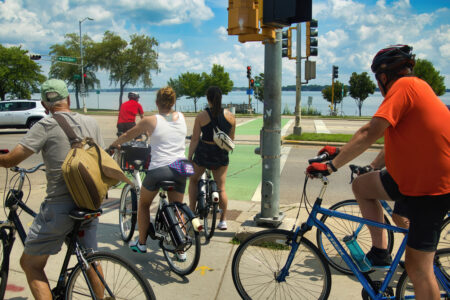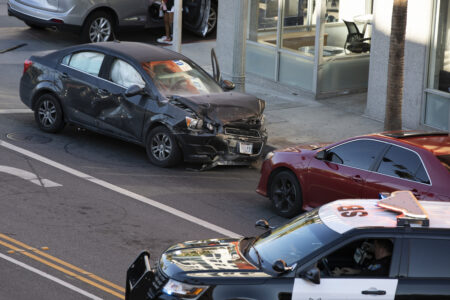
Share On Social!
America’s approach to road safety continues to fail, especially for pedestrians.
The number of people walking who have been struck and killed by people driving grew 45% from 2010 and 2019, according to the new Dangerous by Design report from Smart Growth America and the National Complete Streets Coalition.
Why?
Policymakers in cities and states across the country continue to trust unsafe street design practices that prioritize speed for people driving, enable larger vehicles, and rely on police enforcement and ineffectual education campaigns to promote safety.
Experts urge federal, state, and local leaders to adjust road design to prioritize pedestrians and other forms of active travel such as bicycling, as well as quit blaming individuals and relying on police.
The Most Dangerous Places to Walk in the United States
As in past years, the 2021 edition of Dangerous by Design ranks 50 states and the nation’s largest 100 metropolitan areas based on Pedestrian Danger Index (PDI) scores. The report uses fatal traffic crash data between 2010 and 2019.
“The four most recent years on record (2016-2019) are now the four most deadly years for pedestrian deaths since 1990,” according to a press release from Smart Growth America.
Since Dangerous by Design 2019, PDI scores increased in 49 out of 50 states and in 84 of 100 metropolitan areas.
This means 49 states and 84 of the 100 largest metropolitan areas got more deadly for people walking.
The same 10 most dangerous states from the 2019 report, including several states with large Latino populations, still hold the title: Florida (26.1% Latino), Alabama (4.4% Latino), New Mexico (49.1% Latino), Mississippi (3.4% Latino), Delaware (9.5% Latino), Louisiana (5.2% Latino), Arizona (31.6% Latino), South Carolina (5.8% Latino), Georgia (9.8% Latino), and Texas (39.6% Latino).
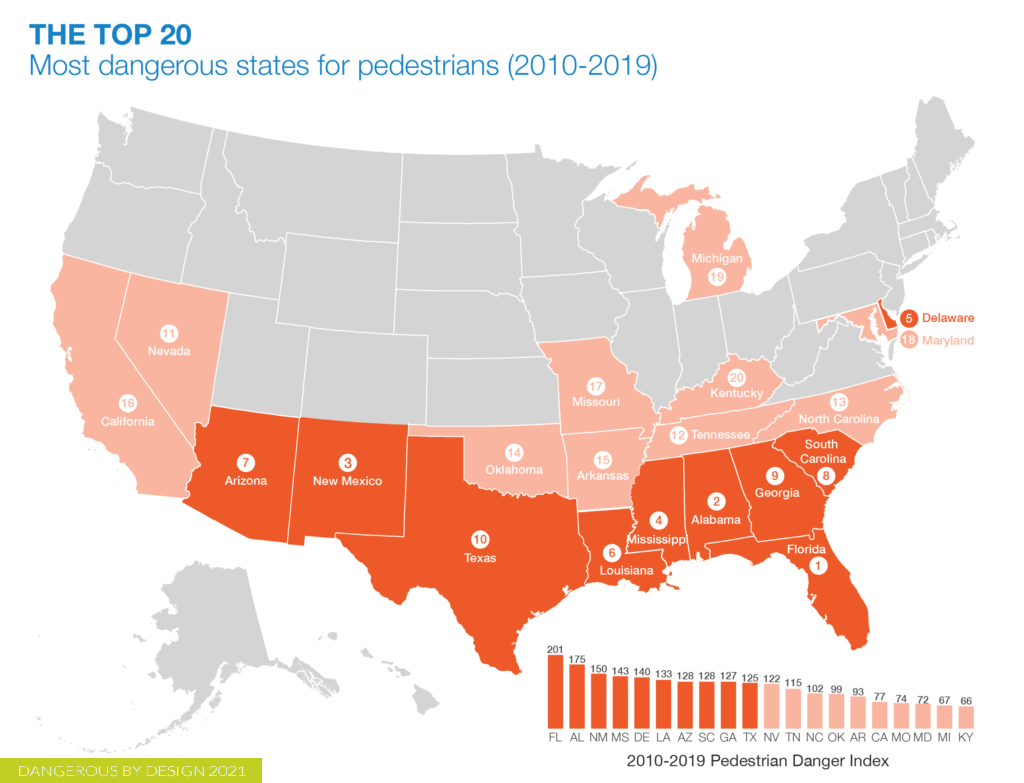
Among the 10 states with the largest increases in 10-year PDI scores, scores increased from 13.4 to 32.2 points from 2008-2017 to 2010-2019, compared to 7.9 to 24.5 points from 2006-2015 to 2008-2017.
PDI scores in 15 metropolitan areas rose by more than 20 points compared to the 2019 report.
Many of these areas are in the U.S. South, with large Latino populations:
- El Paso (81.4% Latino)
- Albuquerque (49.2% Latino)
- Houston (45.0% Latino)
- Tulsa (16.5% Latino)
- Tucson (43.6% Latino)
- Bakersfield, Calif. (50.2% Latino)
For every pedestrian killed, multiple people are forever changed: the victim who dies, the people who loved them, and the person who has to live with knowing that they killed someone.
The problem isn’t that people are walking more, either. “Walking as a share of all trips stayed steady around 10.5%,” according to the report.
The problem is how we design our communities, roads, and vehicles, particularly in low-income communities.
“The fatality rate in the lowest income neighborhoods was nearly twice that of middle income census tracts (in median household income) and almost three times that of higher-come neighborhoods,” according to the press release. “This is unsurprising, given that low-income communities are significantly less likely than higher-income communities to have sidewalks, marked crosswalks, and street design to support safer, slower speeds.”
What Does Dangerous by Design Mean?
The transportation planning process is subject to numerous regulations, requirements, and standards to ensure the best use of public dollars.
But many standards originated during the white-flight, car-centric era of sprawling suburbs.
Now, we have decades of data on the social, environmental, and health harms of segregated, sprawling development, and auto-dependence.
Dangerous by design is related to the institutional standards and practices that dictate community design, roadway design, methods to establish speed limits, motor vehicle design, and safety performance targets.
Dangerous by Design: Roadways
To keep up with sprawling development, roadway design metrics have focused exclusively on keeping drivers moving and minimizing how often drivers need to slow down.
The result is roads with wide lanes, long distances between intersections, wide intersections, and right turn “slip” lanes.
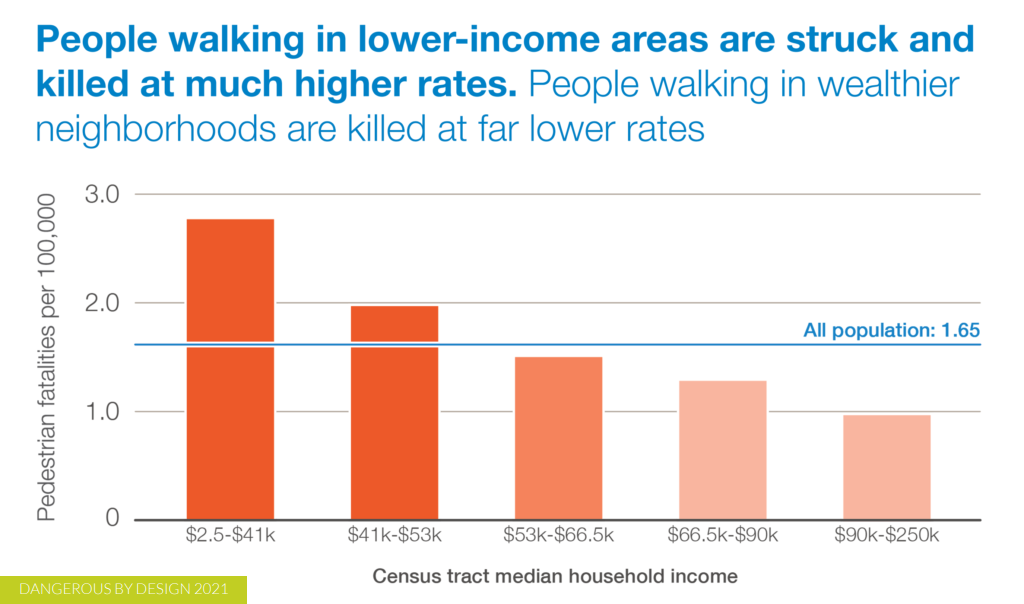
This approach has a huge downside for people walking as well as for people driving.
The U.S. is No. 42 of 51 high-income nations for per capita traffic fatalities, according to the National Safety Council (NSC).
With less congestion amid COVID-19, speeds are up even higher.
Traffic fatalities are, too.
“The preliminary estimated rate of death on the roads last year spiked 24% over the previous 12-month period, despite miles driven dropping 13%,” according to the NSC.
This suggests that congestion is a protective factor against and roadway design is a risk factor for speed.
Some safe design practices that help to slow drivers and save lives include:
- Narrow travel lanes
- High-visibility crosswalks and high-visibility mid-block crosswalks
- Extending curbs to narrow wide intersections
- Decreasing distance between intersections
- Replacing right turn “slip” lanes with right-angle turns
“Designing roads for slower speeds that are self-enforcing also reduces the need to rely on law enforcement, which can pose disproportionate financial and legal burdens on lower-income people,” according to Dangerous by Design.
Dangerous by Design: Speed
Speed limits are another reason for dangerously designed roads.
The “85th percentile method” of determining a speed limit says, roughly, that if 85% of people are driving a certain speed, that should be the speed limit.
For example, if results of a speed survey show that at least 85% of drivers are going 38 mph in a 35 mph zone, the city should raise the speed limit to 40 mph.
This means the law is changed because enough people broke it. Watch this video to learn more.
Imagine if 85% of drivers pulled over for intoxicated driving had a blood alcohol content (BAC) of 0.09% so the the federal limit of 0.08% was raised to 0.10%.
Streets where the speed limit was established based on the assumption that 85% of drivers will obey the law are dangerous by design. They encourage faster driving speeds and limit cities’ ability to lower the posted limit in response to rising crash rates or presence of pedestrians.
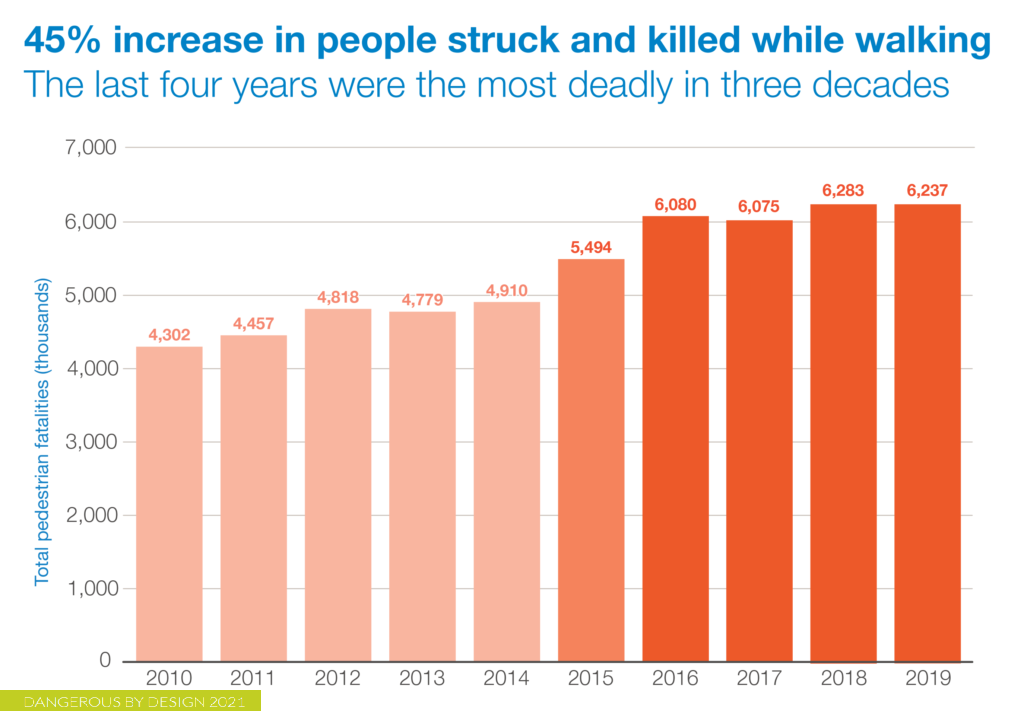
At 30 mph, 45% of crashes involving a person walking are fatal, according to the report. At 40 mph, the fatality rate jumps to 85%.
Crashes at these speeds are even more fatal for older adults.
Injury and death from crashes result from the transfer of kinetic energy. The higher the speed, the greater the amount of kinetic energy.
Just changing the speed limit might not do much. You need to change the design of the road, too.
Unfortunately, roads in America are not designed based on the tolerance of the human body to injury from the transfer of kinetic energy.
Alternative approaches to setting speed limits, which incorporate factors such as crash history and the presence of pedestrians, are available, but not frequently used.
“To prevent road death and disabling injury, a traffic system better adapted to the physical vulnerabilities of its users needs to be created—with the use of more crash-protective vehicles and roadsides,” according to a 2008 report from the World Health Organization (WHO).
Dangerous by Design: Large Vehicles
Dangerous by design also refers to motor vehicle safety standards, which are the federal regulations specifying design, construction, and performance of motor vehicles.
Crashes are more fatal for people walking when involved with trucks, vans, and SUVs.
In a crash, trucks and SUVs are up to three times more likely than smaller personal vehicles to kill people walking, according to the report.
This is particularly problematic because more people are driving trucks and SUVs than before. These vehicles are getting bigger and heavier, too.
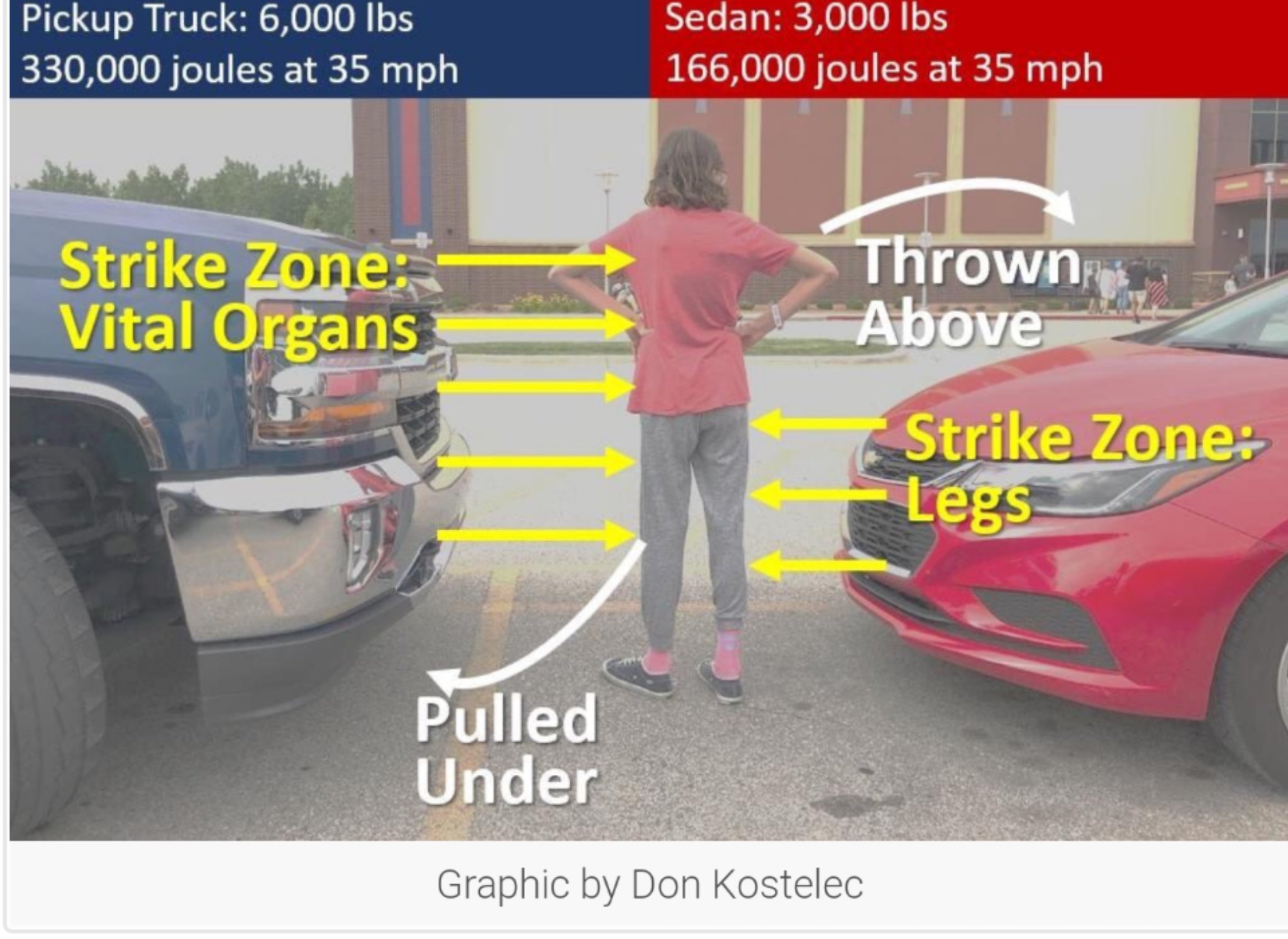
Pick-up trucks, for example, are roughly 1,200 pounds heavier than they were in 1990.
The higher the speed and the heavier the vehicle, the greater the amount of kinetic energy.
Unfortunately, vehicles are not designed based on the tolerance of the human body to injury from the transfer of kinetic energy for non-occupants.
These vehicles are dangerous by design, but the government has failed to act on motor vehicle safety standards.
“The National Transportation Safety Administration issued recommendations in 2018 to revise motor vehicle safety standards to better protect pedestrians, but federal policymakers have so far failed to make changes,” the report states.
Dangerous by Design: Safety Targets
Dangerous by design also refers to the methods used to establish safety performance targets, like number of fatalities.
Like any performance measure, these methods are critical for assessing state and federal investments in transportation.
The problem is the methods result in safety targets for more fatalities year after year.
In 2017, 18 states set targets to increase non-motorized deaths and serious injuries.
The following year, 10 of those 18 failed and exceeded their targets.
However, according to federally established performance measures, this failure is acceptable and does not impact transportation funding.
It gets worse.
In 2020, 20 states set safety targets that would allow more non-motorized deaths and serious injuries than the previous year, according to the report.
This would be absurd in any other profession.
Imagine a federally-funded health center that sets a target for more deaths year after year. Then they failed to achieve those targets or saw more death─and still retained federal funding.
Most would seek to overhaul the health center’s institutional practices or drop funding altogether.
It is time to require an institutional overhaul of our transportation with a public health approach to improve systemic conditions rather than fixate on individual behavior change.
What You Can Do to Push for Safer Roads
The Dangerous by Design report calls out various actions among the following sectors to address the problem:
- Congressional policymakers should create policy that changes how we fund, design, and measure the success of streets nationwide to make safety our highest priority.
- Congress should pass the Complete Streets Act, which sets aside funding for complete streets.
- The S. Department of Transportation (USDOT) can require that states stop setting negative injury and fatality targets.
- USDOT can update federal manuals for roadway design and operations to change standards that contribute to hostile conditions for people walking.
- The National Traffic Safety Administration (NHTSA) should update its guidance and approach to deprioritize traffic enforcement and revise vehicle safety standards to better protect pedestrians.
- NHTSA can improve current national data on the street conditions where fatalities occur, the demographics of the victims, and other conditions of the crash.
- States must implement performance measure to reduce the number of people killed while walking.
- States can provide engineers with the most up-to-date training and education on implementing Complete Streets
- All levels of government should prioritize projects that bring the greatest benefits to those who are suffering disproportionately.
You can reach out to decisionmakers in these sectors to tell them you support and push for the above solutions.
You can do this as individual by email, phone, or social media. Or you can join a local pedestrian safety advocacy group and push for improved safety together.
Join a webinar on March 25 with Smart Growth America and the National Complete Streets Coalition
The National Safety Council provides some additional ways you can get involved:
- Sign on to this letter to President Biden asking for a national, public commitment to reducing traffic fatalities to zero.
- Join the #ZeroTrafficDeaths conversation to share your story and hear from others about why they support the call for zero traffic deaths. Here are instructions.
“Policymakers have disregarded this problem for too long and failed to change how we fund, design, operate, maintain, and measure the success of our roads,” the report states. “They have failed to make vehicles safer for people walking. Despite what they claim about safety, they continue to prioritize moving cars at high speeds.”
Explore More:
Transportation & MobilityBy The Numbers
27
percent
of Latinos rely on public transit (compared to 14% of whites).

